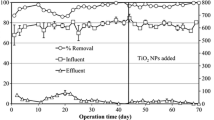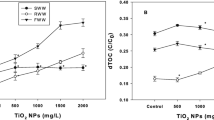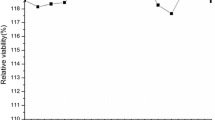Abstract
The potential impact of titanium dioxide nanoparticles (TiO2 NPs) on nitrogen removal from wastewater in activated sludge was investigated using a sequencing batch reactor. The addition of 2–50 mg L−1 of TiO2 NPs did not adversely affect nitrogen removal. However, when the activated sludge was exposed to 100–200 mg L−1 of TiO2 NPs, the effluent total nitrogen removal efficiencies were 36.5 % and 20.3 %, respectively, which are markedly lower than the values observed in the control test (80 %). Further studies showed that the decrease in biological nitrogen removal induced by higher concentrations of TiO2 NPs was due to an inhibitory effect on the de-nitrification process. Denaturing gradient gel electrophoresis profiles showed that 200 mg L−1 of TiO2 NPs significantly reduced microbial diversity in the activated sludge. The effect of light on the antibacterial activity of TiO2 NPs was also investigated, and the results showed that the levels of TiO2-dependent inhibition of biological nitrogen removal were similar under both dark and light conditions. Additional studies revealed that different TiO2 concentrations had a significant effect on dehydrogenase activity, and this effect was most likely the result of decreased microbial activity.







Similar content being viewed by others
References
Adams LK, Lyon DY, Alvarez PJJ (2006) Comparative eco-toxicity of nanoscale TiO2, SiO2, and Zno water suspensions. Water Res 40:3527–3532
APHA (1998) Standard methods for the examination of water and wastewater, 20th edn. American Public Health Association, Washington DC
Bassam B, Caetano-Anollés G, Gresshoff P (1991) Fast and sensitive silver staining of DNA in polyacrylamide gels. Anal Biochem 196:80–83
Blaster SA, Scheringer M, Macleod M, Hungerbuhler K (2008) Estimation of cumulative aquatic exposure and risk due to silver: contribution of nano-functionalized plastics and textiles. Sci Total Environ 390:396–409
Block SS, Seng VP, Goswami DY (1997) Chemically enhanced sunlight for killing bacteria. J Sol Energy Eng 119:85–91
Choi O, Hu ZQ (2008) Size dependent and reactive oxygen species related nanosilver toxicity to nitrifying bacteria. Environ Sci Technol 42:4583–4588
Ge Y, Schimel JP, Holden PA (2011) Evidence for negative effects of TiO2 and ZnO nanoparticles on soil bacterial communities. Environ Sci Technol 45:1659–1664
Giammar DE, Maus CI, Xie LY (2007) Effects of particle size and crystalline phase on lead adsorption to titanium dioxide nanoparticles. Environ Eng Sci 24:85–95
Gottschalk F, Sonderer T, Schoiz RW, Nowack B (2009) Modeled environmental concentrations of engineered nanomaterials (TiO2, ZnO, Ag, CNT, Fullerenes) for different regions. Environ Sci Technol 43:9216–9222
Julia F, Shona RF, Jonna CR, Jamie RL (2009) Silver nanoparticle impact on bacterial growth: effect of pH, concentration, and organic matter. Environ Sci Technol 43:7285–7290
Keller AA, Wang H, Zhou D, Lenihan HS, Cherr G, Cardinale BJ, Miller R, Ji Z (2010) Stability and aggregation of metal oxide nanoparticles in natural aqueous matrices. Environ Sci Technol 44:1962–1967
Kim SC, Harrington MS, Pui DYH (2007) Experimental study of nanoparticles penetration through commercial filter media. J Nanopart Res 9:117–125
Kiser MA, Westerhoff P, Benn T, Perez-Rivera J, Hristovskj K (2009) Titanium nanomaterial removal and release from wastewater treatment plants. Environ Sci Technol 43:8423–8429
Klaine SJ, Alvarez PJ, Batley GE, Fernandes TF, Handy RD, Lyon DY, Mahendra S, McLaughlin MJ, Lead JR (2008) Nanomaterials in the environment: behavior, fate, bioavailability, and effects. Environ Toxicol Chem 27:1825–1851
Kwark SY, Kim SS (2001) Hybrid organic/inorganic reverse osmosis (RO) membrane for bactericidal anti-fouling. 1. Preparation and characterization of TiO2 nanoparticle self-assembled aromatic polyamide thin film composite (TFC) membrane. Environ Sci Technol 35:2388–2394
Limbach LK, Bereiter R, Müller E, Krebs R, Gälli R, Stark WJ (2008) Removal of oxide nanoparticles in a model wastewater treatment plant: influence of agglomeration and surfactants on clearing efficiency. Environ Sci Technol 42:5828–5833
Lonnen J, Kilvington S, Kehoe SC, Al-Touati F, Mcguigan KG (2005) Solar and photozoan, fungal and bacterial microbes in drinking water. Water Res 39:877–883
Lv Z, Yao Y, Min H (2008) Effect of tetrahydrofuran on enzyme activities in activated sludge. Ecotoxicol Environ Saf 70:259–265
Maynard AD, Aitken RJ, Butz T, Colvin V, Donaldson K, Oberdoster G, Philbert MA, Ryan J, Seaton A, Stone V, Tinkle SS, Tran L, Walker NJ, Warheit DB (2006) Safe handling of nanotechnology. Nature 444:267–269
Moore MN (2006) Do nanoparticles present ecotoxicological risks for the health of the aquatic environment. Environ Int 32:967–976
Nel A, Xia T, Madler L, Li N (2006) Toxic potential of materials at the nanolevel. Science 311:622–627
Nowack B, Bucheli TD (2007) Occurrence, behavior and effects of nanoparticles in the environment. Environ Pollut 150:5–22
Rincon AG, Pulgarin C (2005) Use of coaxial photocatalytic reactor (CAPHORE) in the TiO2 photo-assisted treatment of mixed Escherichia coli and Bacillus subtilis and the bacterial community present in wastewater. Catal Today 101:331–344
Rodríguez DC, Pino N, Peñuela G (2011) Monitoring the removal of nitrogen by applying a nitrification-de-nitrification process in a SBR. Bioresour Technol 102:2316–2321
Wan CL, Du MA, Lee DJ, Yang X, Ma WC, Zheng LN (2011) Electrokinetic remediation and microbial community shift of β-cyclodextrin-dissolved petroleum hydrocarbon-contaminated soil. Appl Microbiol Biotechnol 89:2019–2025
Warren WS, Ahn S, Mescher M, Ugurbil K, Richter W, Rizi RR, Hopkins J, Leigh JS (1998) MR imaging contrast enhancement based on intermolecular zero quantum coherences. Science 281:247–251
Wei C, Lin WY, Zainal ZZ, Williams NE, Zhu K, Kruzic AP, Smith RL, Rajeshwar K (1994) Bactericidal activity of TiO2 photocatalyst in aqueous media: toward a solar-assisted water disinfection system. Environ Sci Technol 28:934–938
Zhang WX, Karn B (2005) Nanoscale environmental science and technology: challenges and opportunities. Environ Sci Technol 39:94A–95A
Zhen X, Chen YG, Wu R (2011) Long term of titanium dioxide nanoparticles on nitrogen and phosphorus removal from wastewater and bacterial community shift in activated sludge. Environ Sci Technol 45:7284–7290
Zheng X, Wu R, Chen YG (2011) Effect of ZnO nanoparticles on wastewater biological nitrogen and phosphors removal. Environ Sci Technol 45:2826–2832
Acknowledgments
This work was supported by the National Natural Science Foundation of China (Grant No. 51078102) and the Funds for Creative Research Groups of China (Grant No. 51121062).
Author information
Authors and Affiliations
Corresponding author
Rights and permissions
About this article
Cite this article
Li, D., Cui, F., Zhao, Z. et al. The impact of titanium dioxide nanoparticles on biological nitrogen removal from wastewater and bacterial community shifts in activated sludge. Biodegradation 25, 167–177 (2014). https://doi.org/10.1007/s10532-013-9648-z
Received:
Accepted:
Published:
Issue Date:
DOI: https://doi.org/10.1007/s10532-013-9648-z




